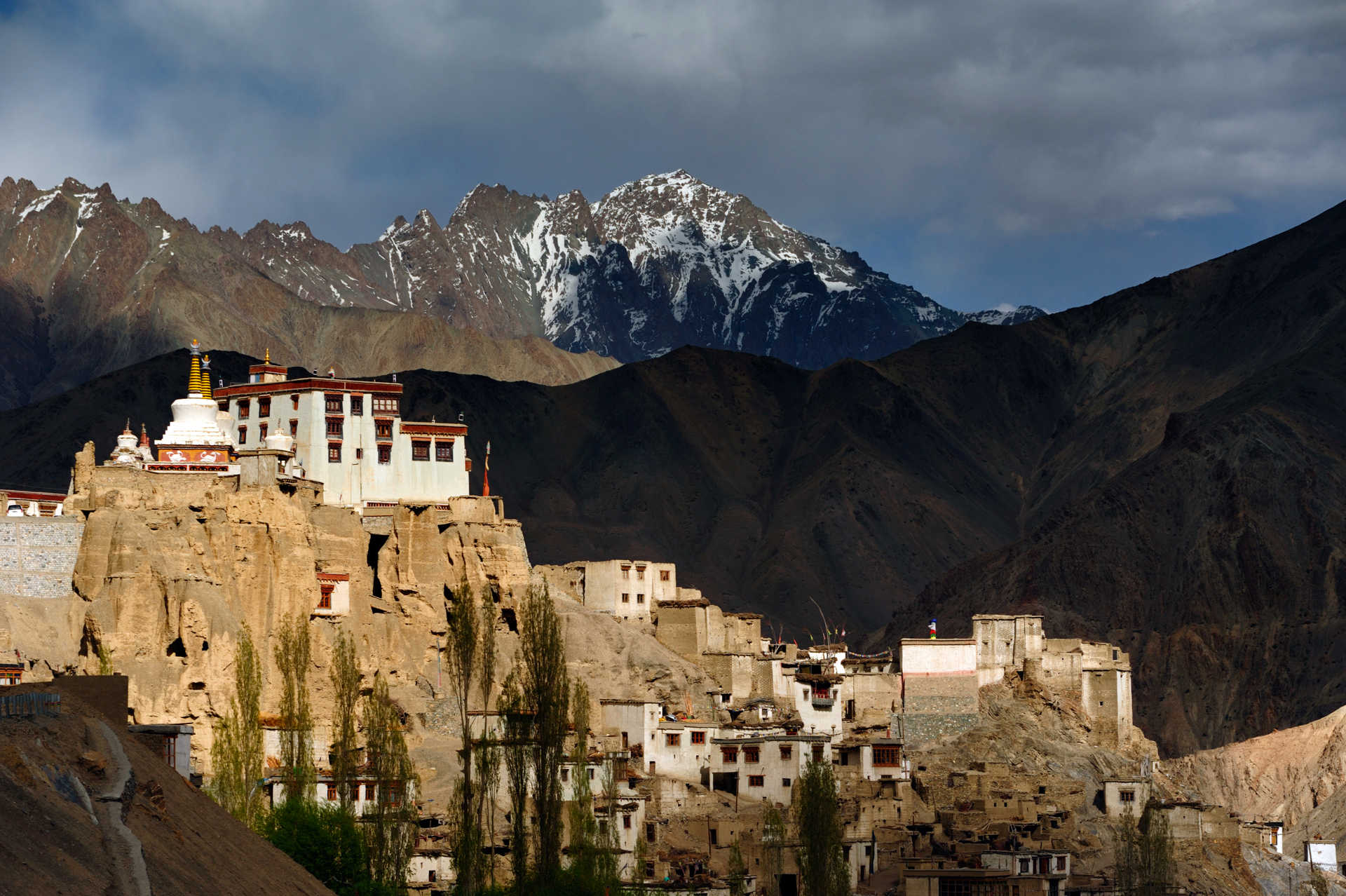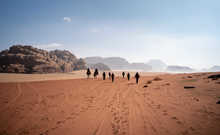Indus Valley Trek
- Kandoo Trekking

Contact
our UK team

Fly into Delhi before changing to a smaller airline for a scenic flight to Leh. Here your guide will meet you at arrivals and you will be transported through the vibrant, mountain town to your accommodation. After a briefing with your guide, you will then be free to roam the town and get acquainted with it's charm.
This will be our first day of exploration, taking place in the outreaches of the upper Indus valley; its beautiful monasteries taking pride of place as symbols of the region. From Leh, we will take a short drive up the valley to begin our tour of local culture and heritage. We start with Shey monastery, former royal capital of the kingdom, whose palace contains an 8-meter high golden Buddha. We will then be treated to a visit to Thiksey monastery. This architectural marvel, miniature of the famous Potala, is incredibly photogenic. It's beautiful works: paintings, masks and thankas all attributed to the monks who live or have lived within it's walls. After perusing these spiritual walls, we then continue our journey to the small monastery of Matho. Once our cultural appetite has been appeased, we return to Leh to sample some of the local cuisine.
We take the road today and descend the great Indus valley. This is an opportunity to appreciate the unique landscapes of the region, roaming between gorges and desert plateaus. Near Nimmoo, we admire the confluence between the two major rivers of Ladakh: where the crystal clear waters of the Zanskar mingle with the turbulent waves of the Indus. We then stop to visit the remote monastery of Basgo, teetering on it's precarious perch, before arriving in the beautiful village of Likir for lunch. In the afternoon, we reach the small settlement of Saspol, it's green pastures a harsh contrast to the dusty, red mountains that tower over it. Here, we explore the caves of hermits, whose walls are adorned with intricate murals. Dating from the 12th century, these are a subtle blend of Indian and Tibetan Buddhist art.
Back on foot, we begin today with a trek up through the stupa lined streets of local villages before gradually ascending to the Phobe La pass, sitting at 3650m. From there, we then descend by a gentle path that winds through an arid valley, framed by mountains streaked in ochre and pink. We arrive at the village of Sumdo and again find some explosive greenery amid the desert-like surroundings. After having rested, we begin the steady ascent up to the Charatse La pass. Here we arrive at the delightful village of Yangthang, settled amid the towering peaks of the Zanskar massif, we set up our camp for the night.
Waking amongst the stunning views of Yangthang, we cross the village and join the river as it meanders it's way through the steep sided valley, then climb the winding path to the sun-baked high point of the Sarmathang La pass. At the top of the pass, we admire the panorama of sandy peaks, regaining our energy, before descending to the pretty village of Hemishukpachan, arguably the most beautiful in Ladakh. We continue the hike traversing the rocky outcrops of the Mebtak La, before descending to the village of Themisgam. Here we can relax and explore the traditional atmosphere of this rural village, a patchwork of barley fields interspersed with sumptuous apple and apricot trees. This marks the end of the Sham valley section of our trek.
After breakfast we continue to hike along the web of barley fields, following the crystal, clear waters weaving along the valley bottom, until we reach Tia village. From here we climb gently for an hour or so to the dusty outcrops of the Chamla pass, before descending past white-washed Chortens to the charming Skindiyang village. After a short, steep descent, we reach the valley floor and our vehicle. Load up bags and relax whilst we follow the winding road, marvelling at the ochre peaks before arriving at Lamayuru. Here, we visit the Lamayuru monastery, an eleventh century monastery which has three important temples perched on a rocky outcrop overlooking the village. Spend the afternoon taking in the traditional, local culture or embark upon one of the numerous hiking opportunities available around the village of Lamayuru.
We leave Lamayuru on foot this morning, heading for the lower slopes of the formidable Zanskar range. Trekking up a narrow valley, we gradually reach the Prinkiti La, a pass of 3700 m. From the top, we admire a stunning panorama that overlooks all the mountains of the majestic North Zanskar. We then descend into a steep-sided, narrow canyon which opens out as we arrive into the village of Wanla. Here the rugged peaks of the Zanskar give way to the alluring greens of the valley floor. Our vehicle awaits us and we make the drive to Alchi, a traditional village in the Indus Valley renowned for having the oldest monastic complex in Ladakh (founded between 958 and 1055 AD). The particularly magnificent mural frescoes, jewels of Indo-Tibetan art are classified by UNESCO as a World Heritage Site.
The trekking part of our trip now over, we leave this area of the region and take the road towards Leh. Along the way, we discover the village of Phyang and visit the local monastery, built at the beginning of the 16th century by King Jamyang Namgyal it contains various representations of the Buddha.
After lunch sampling the local cuisine in Leh, we then follow the winding road up the Indus Valley taking in the beautiful mountain vistas at each turn. On route, we will visit the monastery of Hemis, one of the most affluent in the region. Built in 1605, it has nearly 500 monks and a unique collection of small paintings retracing the life of the great masters of Lamaism. We then end the day with a last road trip, to reach the village of Sakti.
This morning we venture into one of the wildest regions of the Indian Himalayas, the Changtang highlands. Here we are a stone's throw from Tibet, in an area that only Changpa nomads roam during the summer months. We arrive on the shores of one of the most beautiful lakes in the region, the Tso Moriri. The waters of this large lake offer incredible shades of blue, similar to those of the famous Nam Tso and Yamdrok Tso lakes in central Tibet. We take advantage of the surroundings with a short walk on the gentle shores of the lake and admire the electric hues of the setting sun reflected in the water.
Wake up early with the possibility of visiting the elusive nomads who generally reside in a valley not far from here, then there is the option to stroll along the shores of this mesmerising lake. Take the time to soak up the calm, serene atmosphere of the lakeshore, keeping your eyes peeled for the endangered Goa antelope and Tibetan Gazelle which graze the nearby pastures. In the afternoon, take a scenic drive to Lake Tso Kar, the "white lake" in Ladakhi, given this name due to the amount of salt present in its waters. It's richness in minerals causes it to be an important stage in the migration of many birds, and a well-known breeding ground for all bird watchers.
This morning we take a short hike along the shores of Lake Tso Kar, in landscapes of contrasting colours, from the ochre of the mountains to the azure blue of the lake, to the dazzling white of the salt crystals. After savouring our last moments in the solitude of the Changtang highlands, we take the road to return to Leh via the pass of Tanglang La. A free evening in the capital gives you the opportunity to browse it's vibrant bazaar and bustling restaurants.
We will collect you from your hotel and transfer you to Leh Airport for your departing flight.
Fixed camps at Lake Tsomoriri provide large, canvas tents for two people,
equipped with comfortable beds (real mattresses), pillows, sheets and towels.
Each tent has a private bathroom with cold water. Hot water in a bowl can be provided here as well so you can have a wash in the evenings.
It is a requirement of joining any of our treks that you attend a pre-trek briefing the evening before the trek begins. This gives our guides the opportunity to speak to you about your adventure, and sort out any last-minute queries or concerns. We will also carry out a pre-trek health check which must be completed before you trek to high altitude. In Ladakh this is held at 5pm on the evening of Day 1 at your pre-trek hotel, your guide will meet you there.
In India, tipping is a common practice and highly appreciated. The amount you tip depends on the level of service you feel you have received. We recommend budgeting roughly 4500 INR (equivalent to US$50 / £40) per person per week for tips. The amounts given below are not exact and are only given as an indication:
We say goodbye to our porters at the end of our trek. Any tips that you wish to give to the porters will need to be carried on the trek with you. Your guide and driver will accompany you back to your hotel and can be tipped after you return to Leh at the end of the tour.
UPPER BODY
LEGS
FEET
OTHER ACCESSORIES
| From | To | Price | Availability | Book | Enquire |
|---|---|---|---|---|---|
| 15/06/2026 | 26/06/2026 | £1,699 $2,199 |
Available
|
Book now | Enquire now |
| 24/07/2026 | 04/08/2026 | £1,699 $2,199 |
Available
|
Book now | Enquire now |
| 26/08/2026 | 06/09/2026 | £1,699 $2,199 |
Available
|
Book now | Enquire now |
| 14/06/2027 | 25/06/2027 | £1,699 $2,199 |
Available
|
Book now | Enquire now |
| 26/07/2027 | 06/08/2027 | £1,699 $2,199 |
Available
|
Book now | Enquire now |
| 23/08/2027 | 03/09/2027 | £1,699 $2,199 |
Available
|
Book now | Enquire now |
Want to ask us a question or book a private trip? Don't hesitate to contact us!
Contact us